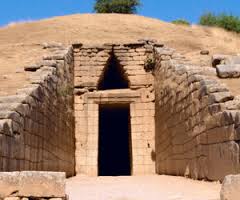Hector on “The Iliad”
Hector was a Trojan hero. His priority was war, not his wife, nor his son. He was a battle leader who killed many. Honor was the reason he fought for, also fame for his name, his wife, and his son. All he wanted was the victory of Troy and the destruction of its enemies. He believed in Zeus, and their other gods. He was Troy’s only protector, and to the people of Troy he was a great man with great courage. However, when Achilles chased him down, he fled various times until he decided to be a coward no more. This led to his death, and the pride of Achilles.
Now, Hector remains as a legend of Troy, and a warrior.
Mycenaean Greece
Mycenaean Greece being unknown was discovered by a German man named Heinrich Schliemann.
The Mycenaean civilization originated and evolved from the society and culture of the early and middle Helladic periods in mainland Greece. It emerged on circa 1600 B.C., when Helladic culture was transformed under influences from Minoan Crete. Later on, the Mycenaean’s defeated the Minoans, and according to the Hellenic legend they also defeated Troy. However, it remains uncertain.
Its society appears to have been divided into two groups of free men: the king’s entourage, who conducted administrative duties at the palace, and the people who lived at the common level. The ones at the common level were watched by royal agents and were obliged to perform duties for and pay taxes to the palace.
Their religion element is difficult to identify, but from existing evidence it seems that Mycenaean religion was the mother of the Greek religion. In it there lies Poseidon, he was a chthonic deity connected with the earthquakes, and he also represented the river spirit of the underworld. Also to be found a collection of “Ladies”, in an inscription at Knossos in Crete we find the “mistress of the Labyrinth”, who calls to mind the myth of the Minoan labyrinth. They relate these with the precursor goddess of Demeter, Persephone, and Poseidon.
We also find Demeter and her daughter Persephone, the goddesses of the Eleusinian mysteries. Poseidon, appearing a as horse pursues Demeter. Demeter becomes a mare and from the union she bares a horse Arion and a daughter, “Desppina”. Pausanias mentions animal-headed statues of Demeter and of other gods in Arcadia.
Then Artemis appears as a daughter of Demeter in the Arcadian cults and she became the most popular goddess in Greece. Her precursor goddess is represented between two lions on a Minoan seal and also on some gold rings from Mycenae. Artemis was also connected with the Minoan “cult of the tree”, an ecstatic and orgiastic cult.
Also, we find Paean who is probably the precursor of the Greek physician of the gods in Homer’s Iliad. He was the personification of the magic-song which was supposed to “heal” the patient.
Athena is then found, she was probably the goddess of the palace who is represented in the “Procession-fresco” at Knossos.
Then Dionysos, his name is interpreted as “son of Zeus”. His cult is related with Boeotia and Phocis, he is the only Greek god who dies in order to be “reborn”. His myth is related with the Minoan myth of the “divine child” who was abandoned by his mother and then brought up by the powers of nature. Many more gods can be found.
The principal Mycenaean towns were well fortified. There are also isolated forts that undoubtedly served to military control territory. Different types of entrances or exits can be seen: monumental gates, access ramps, hidden doors, and vaulted galleries for escaping in case of a siege. Fear of attack meant that the chosen site must have a cistern or a well at its disposal.
To conclude, whatever were the causes of the disappearance of the Mycenaean civilization, they had definitely disappeared after LHIIIC, when the sites of Mycenae and Tiryns were again destroyed and lost their importance. The beginning of the 11th century B.C. opens a new context, that of the protogeometric, the beginning of the geometric period, the Greek Dark Ages of traditional historiography.









Awesome!!! I learned something new about Mycenae. I think you write well. I also have an essay on Mycenae. (I learn from the Ron Paul Curriculum too). Here is a link to my essay:http://baroquemyriam.wordpress.com/?s=Mycenae
LikeLike
Thanks, that’s cool! I’ll check it out 🙂
LikeLike